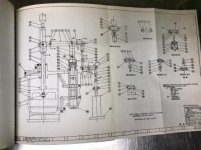Richard King
Diamond
- Joined
- Jul 12, 2005
- Location
- Cottage Grove, MN 55016
I wrote Dave Biering the VP of Technical Sales at TriStar Plastic's about some info he gave me years ago after seeing some Drake Thread Grinders I was rebuilding. It was the first time I had seen a narrow strip glued to a wide cast iron way that the table way ran on. It was about 1/3 the width of the original way. I wrote him asking if that was correct. Last week I was researching a thread for my Facebook forum on rebuilding and asked him to explain it again as I had misplaced his original email. Pretty interesting. I also use to see Saddles on VMC's that had slip stick on the saddle ways that had Turcite on them. Teflon that got sticky?....below explains why.
Rulon is pretty much the same material as Turcite B - both can be considered PTFE (polytetrafluoroethylene)
Richard -- "here is the standard rule of thumb when using Rulon or Turcite as they are essentially the same makeup. (Rulon is better of course!) With the OEM’s in Asia we always instructed them to stay between 35-75psi load and that includes the table weight, maximum work load and a safety factor for possible impact with a tool crash. Too often, especially in Japan and Korea, they would use massive amounts of material and wonder why the friction was so high. The concept of “higher the load, the lower the friction” was not comprehended. The high friction would lead to more heat buildup, chatter and wear. Even lubricated. But when we showed them how to match the loads with the surface area they all learned that less was best. OKK was designing a large mill several years ago and if I recall correctly the table was around 450 x 1800mm and they had a v-slide and two flat slides designed in with very little exposed steel left behind. When I ran the surface area numbers with worse case loads, it calculated out to less than 3psi on the way surfaces. I told them it was going to cause stick slip and high running friction even in oil but alas…… Needless to say after some experimenting they cut the amount of Rulon down by almost 50% to get that load where it needed to be.
So, the two buzz phrases of the day when it comes to slideway bearing materials is “Less is Best” and “The higher the load, the lower the friction!"
Hope this helps.
Best to you and your family.
David Biering
Photo is some Rulon I glued to a Mori-Seiki Lathe crosslide, Blanchard Grinder table and saddle with Rulon - Factory done by Bourne & Koch in Rockford IL, a head-stock I replaced Rulon on Kitamura VMC Headstock, cutting oil grooves and how I used dummy ground bars to replicate the column ways on the floor, so we did not need to remove the column.
Rulon is pretty much the same material as Turcite B - both can be considered PTFE (polytetrafluoroethylene)
Richard -- "here is the standard rule of thumb when using Rulon or Turcite as they are essentially the same makeup. (Rulon is better of course!) With the OEM’s in Asia we always instructed them to stay between 35-75psi load and that includes the table weight, maximum work load and a safety factor for possible impact with a tool crash. Too often, especially in Japan and Korea, they would use massive amounts of material and wonder why the friction was so high. The concept of “higher the load, the lower the friction” was not comprehended. The high friction would lead to more heat buildup, chatter and wear. Even lubricated. But when we showed them how to match the loads with the surface area they all learned that less was best. OKK was designing a large mill several years ago and if I recall correctly the table was around 450 x 1800mm and they had a v-slide and two flat slides designed in with very little exposed steel left behind. When I ran the surface area numbers with worse case loads, it calculated out to less than 3psi on the way surfaces. I told them it was going to cause stick slip and high running friction even in oil but alas…… Needless to say after some experimenting they cut the amount of Rulon down by almost 50% to get that load where it needed to be.
So, the two buzz phrases of the day when it comes to slideway bearing materials is “Less is Best” and “The higher the load, the lower the friction!"
Hope this helps.
Best to you and your family.
David Biering
Photo is some Rulon I glued to a Mori-Seiki Lathe crosslide, Blanchard Grinder table and saddle with Rulon - Factory done by Bourne & Koch in Rockford IL, a head-stock I replaced Rulon on Kitamura VMC Headstock, cutting oil grooves and how I used dummy ground bars to replicate the column ways on the floor, so we did not need to remove the column.








